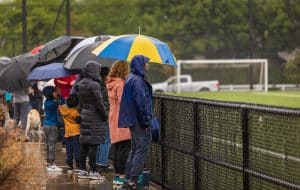Rain can add charm and ambiance to certain events—but when it’s heavy and unrelenting, it becomes a very real safety threat. For organizers of outdoor gatherings like tractor pulls, rodeos, concerts, or county fairs, knowing when to cancel or postpone due to inclement weather is one of the toughest calls to make. However, safety should always be the top priority. In this post, we’ll explore the dangers of heavy rain, the specific risks it poses (such as electrocution), and key factors to consider when deciding whether to proceed with your event.
Understanding the Risks of Heavy Rain
Slippery Surfaces and Traction Issues
Slipping Hazards: When surfaces become wet, the risk of slips, trips, and falls increases dramatically for both attendees and event staff.
Reduced Control for Vehicles and Animals: Tractor pull drivers and rodeo participants especially need stable ground. Mud and standing water can cause loss of control, leading to accidents or injuries.
Structurally Unsound Grounds
Over-saturated Soil: Heavy rainfall can weaken the ground supporting temporary structures, like bleachers, tents, or stages.
Sinkholes and Washouts: In areas prone to flooding or heavy rainfall, the soil can erode beneath walkways or performance areas, creating dangerous cavities or sudden depressions.

The Real Threat of Electrocution
Temporary Power and Water: A Risky Combination
Most large-scale events rely on temporary power setups—generators, extension cords, and portable lighting systems. Water and electricity create a high-risk environment:
Standing Water: Puddles or flooded areas can energize if electrical cords or equipment become submerged.
Loose Cables: Even a small cut in an electrical cable can turn a seemingly harmless puddle into an electrocution hazard.
Overlooked Hazards
Metal Structures: Metal fencing, gates, or bleachers can become conductive when exposed to live electricity in wet conditions.
Ground Fault Circuit Interrupters (GFCIs): While GFCIs greatly reduce the risk of electrocution, they’re not fail-safe. If there are unprotected circuits or older wiring at the event site, the danger escalates quickly.
Setting Clear Cancellation Criteria
Create a Weather Action Plan in Advance
Establishing clear, measurable thresholds for rainfall and severe weather before the event begins takes guesswork out of the decision-making:
Accumulation Levels: Decide on the maximum amount of precipitation the grounds can safely handle.
Storm Severity: Consider real-time weather alerts for thunderstorms or flash flood warnings.
Ground Saturation: If the soil is already saturated from prior rain, it won’t take much additional precipitation to create hazardous conditions.
Consult with Safety Experts
If your event involves livestock (rodeo, fair) or heavy machinery (tractor pulls), it’s wise to consult with:
Veterinarians and Animal Handlers: Determine if animals could be stressed or injured by wet, slippery arenas.
Equipment Specialists: Tractor operators and stage technicians can advise on the operational limits of machinery in rain-soaked conditions.
Insurance Requirements
Review your event insurance or event rain insurance policy carefully:
Cancellation Clause: Many policies have language outlining conditions under which the event must be canceled to maintain coverage.
Safety Obligations: Insurers may require that you follow best practices for weather-related emergencies, meaning a voluntary cancellation could be safer—and cheaper—than risking a major accident.
Communicating the Decision to Cancel
Timing Is Everything
Early Warning: Once you realize heavy rainfall is imminent, communicate potential cancellation or postponement to vendors, participants, and attendees as soon as possible.
Stakeholder Notifications: Issue updates via social media, email lists, and text alerts. Keep local news outlets informed if your event is high-profile.
Transparency and Empathy
Safety First: Emphasize in your message that the well-being of everyone involved is the top priority.
Refunds/Rescheduling: Clearly state whether tickets will be refunded or honored at a postponed event date, and provide instructions on how to process any necessary reimbursements.
Reputation Management
While canceling an event can be disappointing—and financially painful—failing to call it off in dangerous conditions may lead to severe injury, negative press, or legal action. Being proactive, transparent, and empathetic can actually boost your organization’s reputation, showcasing your commitment to public safety.
Making the Right Call
Conduct a Final Risk vs. Reward Assessment
Take a moment to weigh the potential costs of going forward:
Financial Liability: Damage to equipment and infrastructure; lawsuits if attendees are injured.
Bodily Harm: No financial gain is worth a life-threatening accident or serious injury to participants or the public.
Long-term Reputation: A single avoidable disaster can tarnish your brand for years.
If You Decide to Proceed
If the weather forecast improves or the rain is manageable, institute heightened safety measures:
Extra Electrical Precautions: Cover cables with waterproof materials, elevate power sources, and use GFCIs wherever possible.
Crowd Control: Close off any flooded or muddy areas, post signage warning of slippery conditions, and deploy additional staff to help direct attendees.
Continuous Monitoring: Keep a close eye on weather apps, local alerts, and on-the-ground conditions. If conditions worsen, be ready to make a last-minute cancellation or pause.
Final Thoughts
When heavy rainfall looms, the decision to cancel or proceed isn’t an easy one. However, the safety of your attendees, participants, and staff must always come first. Take a proactive stance by setting clear criteria, investing in the right insurance and infrastructure, and communicating transparently with everyone involved.
A canceled or postponed event can be rescheduled or reorganized. A tragedy due to preventable hazards, on the other hand, can have permanent consequences for both the individuals involved and your organization as a whole. As you plan your next tractor pull, rodeo, concert, or county fair, remember: playing it safe in the face of heavy rain is the best investment you can make in your event’s future success.
If rain insurance is in place, whether or not or to what extent a particular loss is covered depends on the facts and circumstances of the loss and the language of the policies as issued. Actual coverage is subject to the language of the policies as issued. Policy benefits vary by carrier.


